One new species and one new record species of Sphaerolaimus(Nematode, Sphaerolaimidae) in offshore wetlands, China*
Peipei YANG, Mengdi LIU, Yuqing GUO
Fisheries College, Jimei University, Xiamen 361021, China
Abstract One new species and one new record species of Sphaerolaimus are described. Sphaerolaimus longispiculatus sp. nov. is characterized by body length 2 213-2 470 μm, amphideal fovea 12%-16%corresponding body diameters in males and 9%-10% corresponding body diameters in females, long slender spicules 2.8-3.8 cloacal body diameters, eight small papilliform precloacal supplements, gubernaculum without apophysis, and tail conico-cylindrical, 2.5-3.7 cloacal/anal body diameters long. Sphaerolaimus gracilis is recorded from the first time in the mangroves wetlands, it can be distinguished from the original desceiption by longer spicules (66-71 μm vs 56 μm) and wider body ( a=20.1-21.4 vs 25).
Keyword: free-living marine nematodes; taxonomy; Sphaerolaimus longispiculatus sp. nov.
1 INTRODUCTION
The genus Sphaerolaimus was established by Bastian in 1865 (Bastian and Lond, 1865). It is characterized by buccal cavity surrounded by a solid,heavily sclerotized buccal capsule. Inner lining of oesophagus is strongly cuticularized. Groups of subcephalic setae are absent in first two juvenile instars, with 4-6 groups in the third stage, and 8 groups in the fourth stage juvenile and adult (Warwick et al., 1998). There are 38 species currently considered valid in genus Sphaerolaimus (Warwick, 1973; Leduc and Zhao, 2017; Bezerra et al., 2019).
To study the species diversity of free-living marine nematodes in off shore wetlands in China, especially mangrove wetlands, sediment samples have been collected from multiple sites in the intertidal to the sublittoral regions in recent years. Up to now, over 20 novel species of free-living marine nematode from the mangroves wetlands have described (Chen and Guo, 2015; Guo et al., 2015, 2018; Li and Guo, 2016).This study describes one new and one new record Sphaerolaimus species in order to enrich the biodiversity of marine nematodes.
List of valid Sphaerolaimus species
S. abeskunus Tchesunov, 1980
S. anterides Inglis, 1961
S. arcospiculum Allgén, 1959
S. balticus Schneider, 1906
= S. bretonicus Kreis, 1929
= S. ditle vs eni Kreis, 1924
S. caspius Tchesunov, 1980
S. crenellatus Warwick, 1973
S. cuneatus Paramonov, 1929
S. ferulaceus Gourbault & Boucher, 1981
S. glaphyrus Vitiello, 1971
S. gracilis De Man, 1876
= S. buetschlii Schulz, 1932
= S. demani Filipjev, 1922
= S. setosus Paramonov, 1927
S. haurakiensis Leduc, D. & Zhao, Z., 2017
S. hirsutus Bastian, 1865
S. ibericus Freudenhammer, 1975
S. kleini Jensen, 1992
S. lamasus Gerlach, 1956
S. latilaimus Allgén, 1958
S. limosus Fadeeva, 1983
S. lutarius Gourbault & Boucher, 1981
S. macrocirculoides Wieser, 1954
S. macrocirculus Filipjev, 1918
S. maeoticus Filipjev, 1922
S. makrolasius Schulz, 1932
S. megamphis Wieser, 1956
S. micropapillatus Tchesunov & Miljutin, 2006
S. minutus Vitiello, 1971
S. occidentalis Turpeenniemi, 1997
S. ostreae Filipjev, 1918
S. pacificus Allgén, 1947
S. papillatus Kreis, 1929
S. paragracilis Vitiello, 1971
S. penicilus Gerlach, 1956
S. peruanus Freudenhammer, 1975
S. profundus Vitiello, 1971
S. rivalis Gagarin, 2014
S. solivagus Galtsova et al., 1980
S. tenuis (Kreis, 1924) Schuurmans Stekhoven,1935
S. uncinatus Freudenhammer, 1970
S. valentinae Tchesunov, 1987
Doubtful species
S. abyssorum Allgén, 1933
S. asetosus Allgén, 1952
S. brevicollis Ssaweljev, 1912
S. duplex Allgén, 1952
2 MATERIAL AND METHOD
Samples were collected from Baiha Island in Xiamen City (118.370°E, 24.531°N) and Maoling River mangrove wetlands in Qinzhou City (108.2860°E,21.5212°N). Samples were collected by pushing a modified syringe with an inner diameter of 2.9 cm into the sediment to a depth of 5 cm, and then fixed with 5%formalin. In the laboratory, samples were slowly washed through mesh of 500 μm and 38 μm with tap water until the majority of clay and silt were washed out, and then extracted marine nematode from the sediment by the Ludox centrifugation (Warwick et al.,1998). Each extracted sample was stained with rose Bengal for more than 24 h, and the meiofauna were counted and classified under a stereomicroscope.Marine nematodes were transferred into an embryo glass dish containing by volume 5% glycerine, 5%pure ethanol, and 90% freshwater (McIntyre and Warwick, 1984), and left in a desiccator for a week.This allows the ethanol and water to evaporate slowly and leave marine nematodes in pure glycerol. The observations were performed using diff erential interference contrast microscopy (Nikon 80i), and the morphology was drawn using a camera lucida.
All measurements are in μm, and all curved structures are measured along the arc. Abbreviations are as follows: a=body length/maximum body diameter, b=body length/oesophagus length, c=body length/tail length, c′=tail length/anal body diameters,V=vulva distance from anterior end. All holotypes and paratypes are deposited in the Institute of Oceanology,Chinese Academy of Sciences, Qingdao, China.
3 SPECIES DESCRIPTION
Family Sphaerolaimidae Filipjev, 1918
Subfamily Sphaerolaiminae Filipjev, 1918
Genus Sphaerolaimus Bastian, 1865
3.1 Sphaerolaimus longispiculatus sp. nov. (Figs.1–3, Table 1)
3.1.1 Basic information
Type material
Four males and two females: Holotype: ♂1 on slide number XMBHJ201504B1017. Paratypes: ♂2 on slide number XMBHJ20140907BM1112, ♂3 on XMBHJ201504AM1006, ♂4 on XMBHJ201406073109, ♀1 on XMBHJ201406071110,and ♀2 on XMBHJ20140907BU1106.
Type locality and habitat
All the specimens were collected from Baiha Island in Xiamen City in June and September 2014, and April 2015. 118.370°E, 24.531°N, subtidal environment, muddy sediment. Total nitrogen,1.31 mg/g; total phosphorus, 0.40 mg/g; organic carbon, 1.72%; sulfide, 16.89×10-6mg/g.Etymology
The species name is composed of the Latin adjective longus and spiculatus, and related to its long spicules.
Measurement

The measurements of the species are shown in Table 1.
3.1.2 Description
Male: Body stout, tapering slightly towards both extremities. Cuticle with obvious transverse striations.Buccal cavity opening surrounded by six small lips with inner labial papillae at the lip base, outer labial sensilla indistinct. Four cephalic setae about 3-μm long. Eight groups of 2-3 subcephalic setae, 3-12-μm long. Multiple rows of somatic setae, 8-11-μm long,extending from level of amphids to cloaca, most dense in pharyngeal region and becoming gradually sparser posteriorly. Amphideal fovea circular, with cuticularized outline, 12%-16% corresponding body diameters. Buccal cavity barrel-shaped and heavily cuticularized, 55-58-μm long and 32-36-μm wide.Numerous longitudinal cheilostomal ridges in anterior part of buccal cavity, and posterior part of buccal cavity with three plate-like structures. Pharyngeal wall with thick cuticle along entire length. Cardia small, surrounded by intestinal tissue. Nerve ring at approximately 34%-36% of pharynx length from anterior. Excretory pore 193-216 μm from anterior end of body, at 34%-40% of the pharyngeal region length.
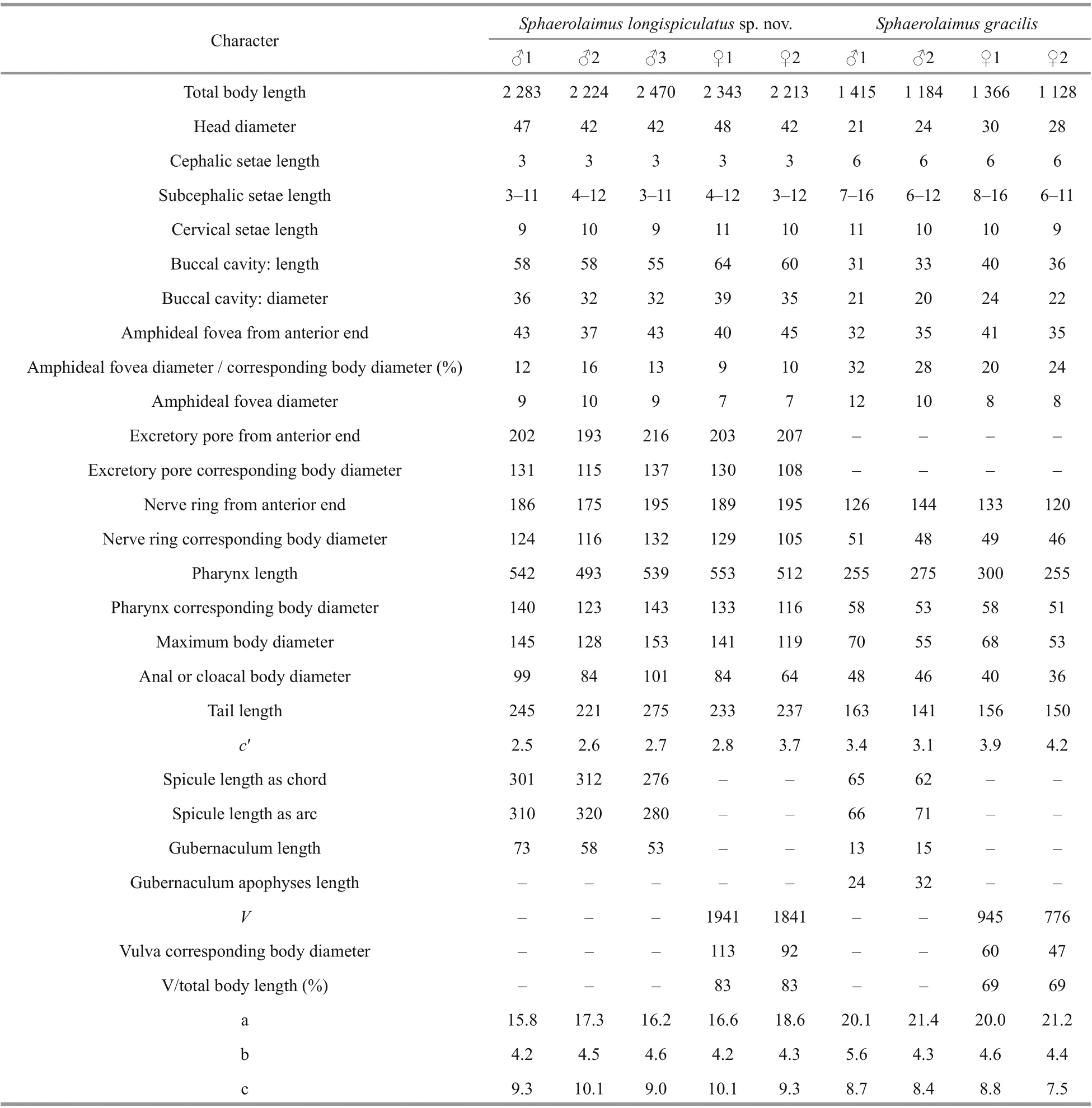
Table 1 Morphometrics (μm) of Sphaerolaimus longispiculatus sp. nov. and Sphaerolaimus gracilis
Reproductive system diorchic with two outstretched testes. Spicules 2.8-3.8 cloacal body diameters long,slightly curved, cephalated proximally and pointed distally. Gubernaculum 53-73-μm long, without apophyses. Eight small papilliform precloacal supplements. Tail conico-cylindrical, the end slightly swollen with three terminal setae, 16-18 μm. Three caudal glands and spinneret present.
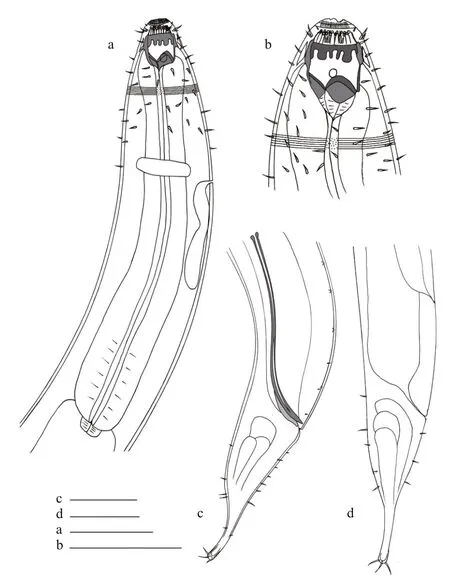
Fig.1 Sphaerolaimus longispiculatus sp. nov. (part 2–1)
Female: Similar to male in general characteristics,except smaller amphideal fovea, 9%-10%corresponding body diameters. Reproductive system monodelphic, with single anterior outstretched ovary situated at the right or left ofintestine. Vulva located at about 83% of the body. Ovoviviparity.
3.1.3 Diagnosis and discussion
Sphaerolaimus longispiculatus sp. nov. is characterized by body length 2 213-2 470 μm,amphideal fovea 12%-16% corresponding body diameters in males and 9%-10% corresponding body diameters in females, slender spicules 2.8-3.8 cloacal body diameters long, eight small papilliform precloacal supplements, gubernaculum without apophysis, and tail conico-cylindrical, 2.5-3.7 cloacal/anal body diameters long.
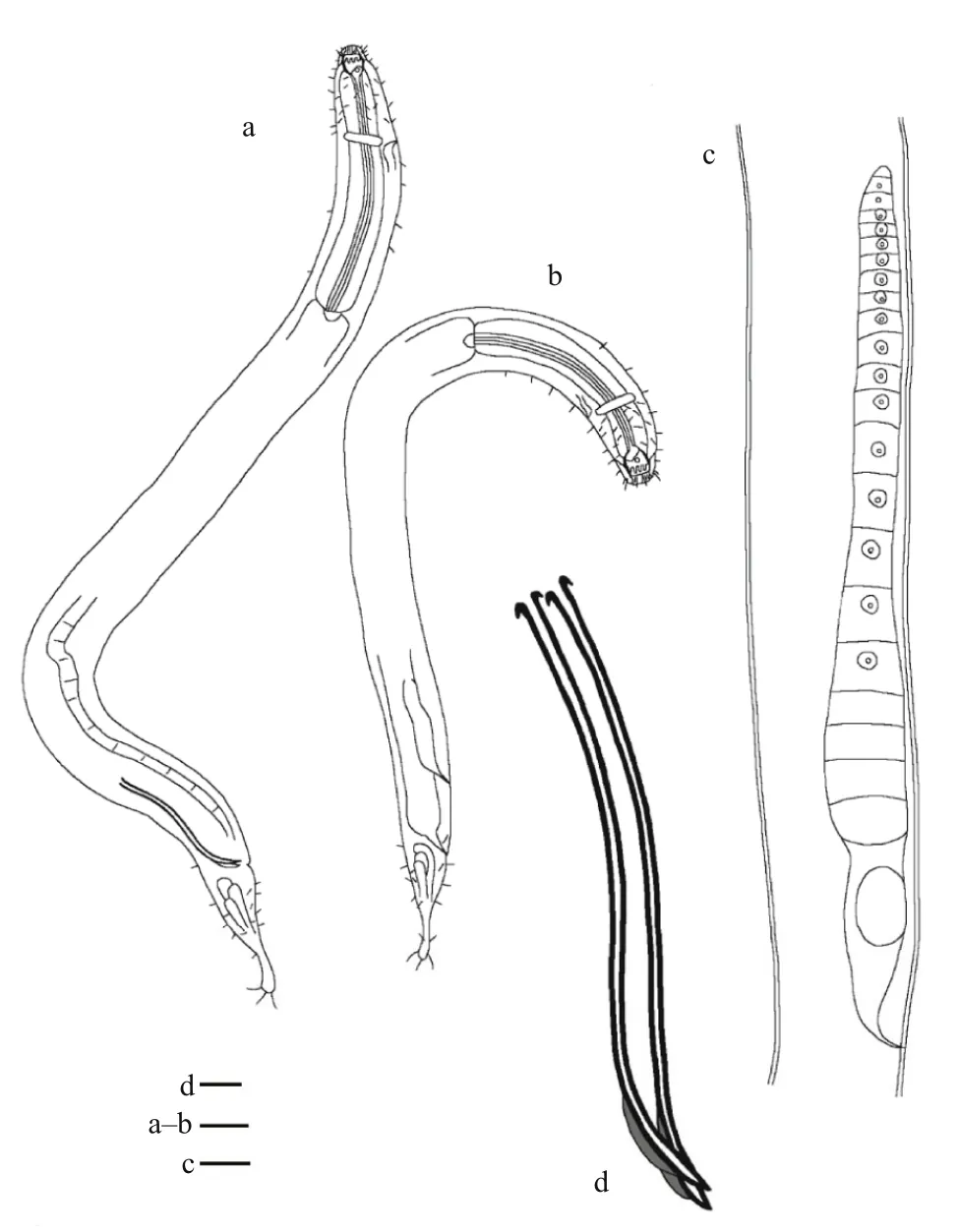
Fig.2 Sphaerolaimus longispiculatus sp. nov. (part 2–2)
Sphaerolaimus longispiculatus sp. nov. can be diff erentiated from most other species of the genus by its long spicule. S. longispiculatus sp. nov.resembles S. cuneatus, S. hirsutus, S. kleini, S.macrocirculoides, S. macrocirculus and S. penicillus in having long spicule. S. longispiculatus sp. nov. can be distinguished from S. cuneatus by lower values of a (15.8-18.6 vs 21.0-24.0) and spicule morphology.S. longispiculatus sp. nov. can be diff erentiated from S. hirsutus by total body length (2 213-2 470 μm vs 2 700-3 300 μm in S. hirsutus) and the shape of gubernaculum (gubernaculum flaky vs gubernaculum small, roughly triangular in S. hirsutus). S.longispiculatus sp. nov. diff ers from S. kleini in the longer body length (2 213-2 470 μm vs 1 142-1 300 μm), smaller amphideal fovea (9%-16%corresponding body diameters vs 22%-45%corresponding body diameters), and longer spicules(280-320 μm vs 73-80 μm). S. longispiculatus sp.nov. diff ers from S. macrocirculoides in the longer body length (2 213-2 470 μm vs 1 500 μm), the number and length of subcephalic setae (eight groups,3-12 μm vs six groups, 10-12 μm). S. longispiculatus sp. nov. can be distinguished from S. macrocirculus by smaller amphideal fovea (9%-16% corresponding body diameters vs 20%-34% corresponding body diameters in S. macrocirculus), and shorter tail length(2.5-3.7 cloacal/anal body diameters vs 4.7-5.7 cloacal/anal body diameters in S. macrocirculus).S. longispiculatus sp. nov. can be distinguished from S. penicillus by length of subcephalic setae (3-12 μm vs 42 μm), size of amphideal fovea (9%-19%corresponding body diameters vs 27% corresponding body diameters in S. penicillus), and the number of precloacal supplements (8 vs 1).
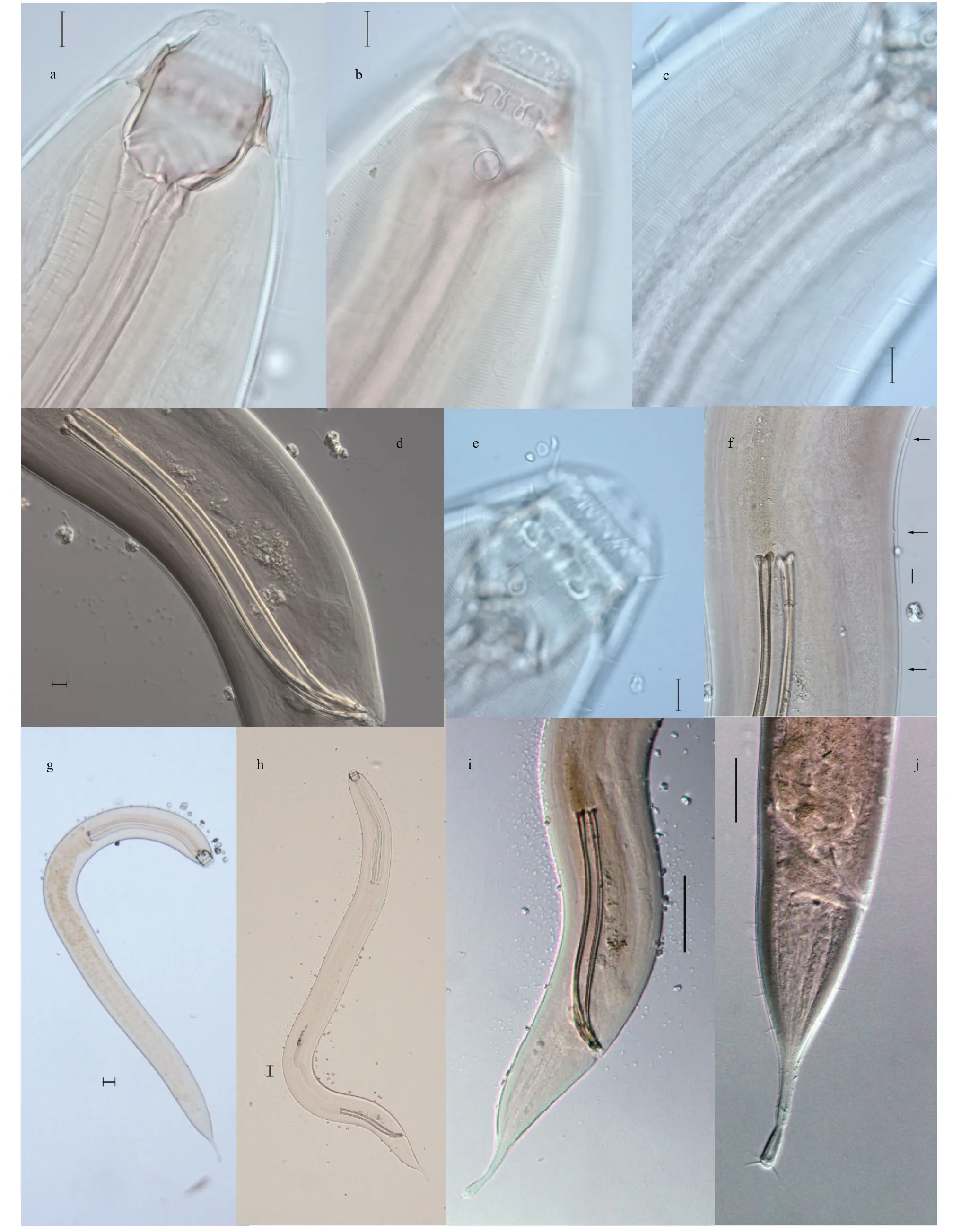
Fig.3 Sphaerolaimus longispiculatus sp. nov.
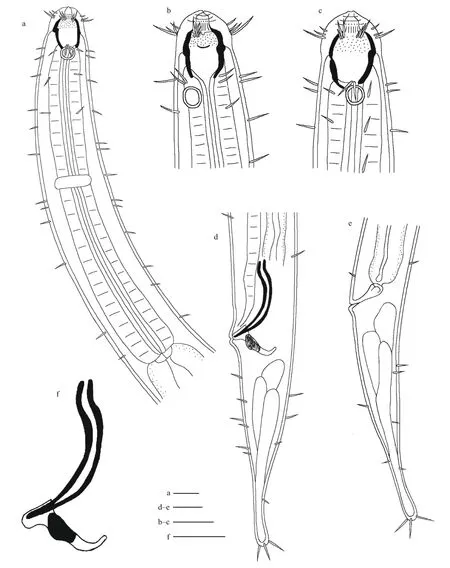
Fig.4 Sphaerolaimus gracilis (part 2–1)
3.2 Sphaerolaimus gracilis (Figs.4–6, Table 1)
3.2.1 Basic information
Type material
Two males and two females. ♂1 on slide number MLJ2018020211. ♂2 on slide number MLJ2018020206, ♀1 on MLJ2018020201, ♀2 on MLJ2018020215.

Fig.5 Sphaerolaimus gracilis (part 2–2)
Type locality and habitat
All the specimens were collected from Maoling River mangroves wetlands in Qinzhou City in February 2018, 108.286 0°E, 21.521 2°N, intertidal zone, muddy sediment.
3.2.2 Description
Male: body cylindrical, tapering slightly towards both extremities. Cuticle with faint transverse striations. Eight rows of somatic setae, 10-11-μm long, more numerous in esophageal region than in midbody. Inner labial and outer labial sensilla indistinct, four cephalic setae 6 μm-long. Eight groups of 2-4 subcephalic setae, 6-16-μm long. Two additional setae located immediately anterior to amphideal fovea. Amphideal fovea circular, with cuticularised outline, 28%-32% corresponding body diameters. Buccal cavity barrel-shaped and heavily cuticularised, 31-33-μm long and 20-21-μm wide.Numerous longitudinal cheilostomal ridges in anterior part of buccal cavity. Pharyngeal wall with heavily cuticularised along entire length. Cardia small,partially surrounded by intestine. Nerve ring at approximately 50%-53% of pharynx length from anterior. Secretory-excretory system not observed.
Reproductive system diorchic with two outstretched testes. Spicules 1.4-1.5 cloacal body diameters long,arcuate. Gubernaculum with 24-32-μm long, heavily cuticularised and curved apophysis, proximal portion of gubernaculum surrounding spicules. Precloacal supplements not observed. Tail conico-cylindrical,with two rows of subventral setae and two rows of subdorsal setae. Three terminal setae, 11-12-μm long.Three caudal gland and spinneret present.
Female: similar to males but with smaller amphideal fovea, 20%-24% corresponding body diameters, and longer tail length. Reproductive system monodelphic and prodelphic, with single anterior outstretched ovary located to the left ofintestine, no spermatheca observed. Vulva situated at 69% of the body; vaginal glands present on either side of proximal portion of vagina.
3.2.3 Diagnosis and discussion The specimens examined here closely resemble the description oflorenzen (1969) based on specimens from the north of Husum, although the Maoling River mangroves wetlands specimens possess slightly longer spicules (66-71 μm vs 56 μm) and wider body( a=20.1-21.4 vs 25).
4 DATA AVAILABILITY STATEMENT
All data generated and/or analyzed during this study are available from the corresponding author on reasonable request.
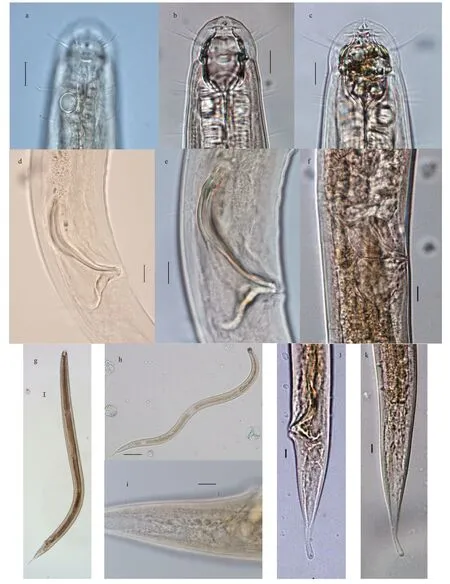
Fig.6 Sphaerolaimus gracilis
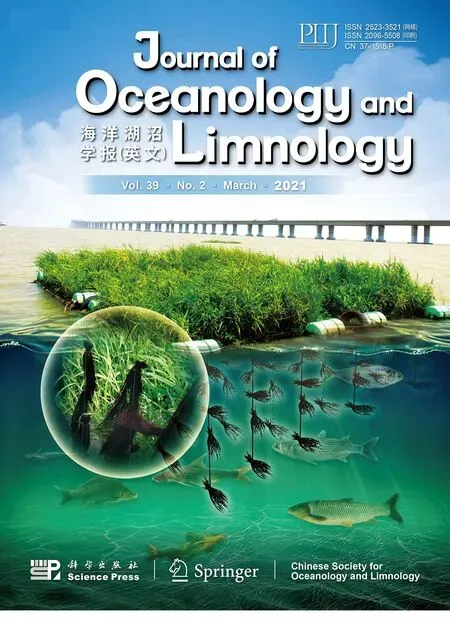 Journal of Oceanology and Limnology2021年2期
Journal of Oceanology and Limnology2021年2期
- Journal of Oceanology and Limnology的其它文章
- Predicting sediment flux from continental shelfislands,southeastern China*
- Laboratory simulation of dissolved oxygen reduction and ammonia nitrogen generation in the decay stage of harmful algae bloom*
- Development of high-resolution chloroplast markers for intraspecific phylogeographic studies of Phaeocystis globosa*
- Effects ofiron and humic acid on competition between Microcystis aeruginosa and Scenedesmus obliquus revealed by HPLC analysis of pigments*
- Effect of river plume on phytoplankton community structure in Zhujiang River estuary*
- Exploring the sublethal genotoxic effects of class II organophosphorus insecticide quinalphos on freshwater fish Cyprinus carpio
